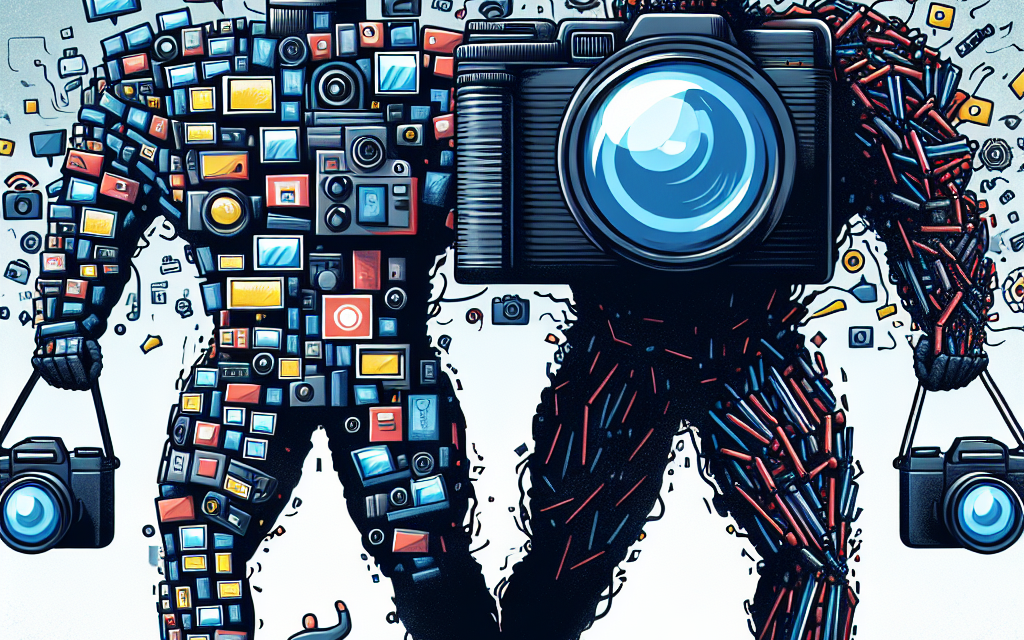“Getty Images and Shutterstock Unite: A $3.7 Billion Visual Content Revolution Begins!”
Introduction
Getty Images has announced its acquisition of Shutterstock in a landmark deal valued at $3.7 billion, creating a formidable powerhouse in the visual content industry. This strategic merger combines two of the leading platforms for stock photography, video, and other multimedia assets, significantly expanding their combined offerings and market reach. The union aims to enhance the user experience by providing a more extensive library of high-quality visual content, catering to the growing demand from businesses, marketers, and creatives worldwide. As the digital landscape continues to evolve, this acquisition positions the newly formed entity as a dominant player, poised to innovate and lead in the competitive visual content market.
Getty Images and Shutterstock: A New Era in Visual Content
In a significant development within the visual content industry, Getty Images has announced its acquisition of Shutterstock, a move that is poised to reshape the landscape of digital imagery and stock photography. This strategic merger, valued at approximately $3.7 billion, marks the beginning of a new era in visual content, combining two of the most prominent players in the market. As the demand for high-quality images continues to surge, this union is expected to create a powerhouse capable of meeting the evolving needs of businesses, marketers, and creatives alike.
The acquisition is not merely a financial transaction; it represents a convergence of resources, expertise, and technology that can enhance the offerings of both companies. Getty Images, known for its extensive library of premium images and editorial content, has long been a leader in the industry. Meanwhile, Shutterstock has carved out a niche with its diverse collection of user-generated content and innovative subscription models. By merging these strengths, the newly formed entity will be better equipped to provide a comprehensive suite of visual solutions that cater to a wide array of clients, from small businesses to large enterprises.
Moreover, this merger is expected to drive innovation in the visual content space. As both companies integrate their technologies and platforms, they will likely invest in advanced tools that leverage artificial intelligence and machine learning. These technologies can enhance search capabilities, streamline content curation, and improve user experience, ultimately allowing customers to find the perfect images more efficiently. The potential for enhanced analytics and insights will also empower clients to make data-driven decisions regarding their visual content strategies.
In addition to technological advancements, the acquisition is anticipated to create a more robust marketplace for creators. By combining their vast networks of photographers, videographers, and artists, Getty Images and Shutterstock can offer a more diverse range of content. This expanded reach not only benefits the companies but also provides creators with greater exposure and opportunities for monetization. As the demand for unique and authentic visual content grows, this merger positions the new entity to attract a wider array of contributors, enriching the overall quality and variety of available imagery.
Furthermore, the consolidation of these two giants may lead to increased competition in the visual content industry. As the combined entity seeks to solidify its market position, it will likely push other players to innovate and enhance their offerings. This competitive environment can ultimately benefit consumers, as companies strive to provide better services, more competitive pricing, and improved user experiences. The ripple effects of this acquisition may encourage smaller firms to explore partnerships or develop unique niches, fostering a dynamic ecosystem within the visual content market.
As we look ahead, the implications of Getty Images’ acquisition of Shutterstock extend beyond mere market share. This merger signifies a pivotal moment in the evolution of visual content, where collaboration and innovation will play crucial roles in shaping the future. By harnessing their combined strengths, Getty Images and Shutterstock are set to redefine the standards of quality and accessibility in the industry. As businesses and creatives navigate this new landscape, they can anticipate a wealth of opportunities and resources that will empower them to tell their stories through compelling visual narratives. In conclusion, this acquisition heralds a transformative chapter in the world of visual content, one that promises to enhance creativity and drive progress in the years to come.
The Financial Implications of the $3.7 Billion Acquisition
The recent acquisition of Shutterstock by Getty Images for a staggering $3.7 billion marks a significant turning point in the visual content industry, with profound financial implications that extend beyond the immediate transaction. This merger not only consolidates two of the largest players in the market but also reshapes the competitive landscape, potentially influencing pricing strategies, market share, and investment opportunities within the sector. As the combined entity seeks to leverage its extensive libraries and technological capabilities, the financial ramifications will be felt across various dimensions.
To begin with, the acquisition is expected to create substantial cost synergies. By integrating operations, Getty Images and Shutterstock can streamline their processes, reduce redundancies, and optimize their supply chains. This efficiency is likely to lead to lower operational costs, which can enhance profit margins. Furthermore, the consolidation of resources may allow for increased investment in technology and innovation, enabling the new powerhouse to develop advanced tools for content creation and distribution. As a result, the potential for improved user experience and customer satisfaction could drive higher revenue growth in the long term.
Moreover, the acquisition is poised to impact pricing strategies within the visual content market. With a combined library of millions of images, videos, and other media assets, the new entity may have greater leverage in negotiating pricing with clients. This could lead to more competitive pricing models, benefiting customers while simultaneously increasing market share. However, it is essential to consider the potential for market monopolization, which could raise concerns among regulators and competitors alike. If the merged company dominates the market, it may stifle competition, leading to higher prices in the long run if alternative providers struggle to compete.
In addition to these operational efficiencies and pricing dynamics, the acquisition also opens up new avenues for revenue generation. The combined expertise of Getty Images and Shutterstock can lead to the development of innovative subscription models and licensing agreements that cater to a broader range of clients, from small businesses to large enterprises. By diversifying their offerings, the new entity can tap into previously underserved markets, thereby expanding its customer base and driving additional revenue streams.
Furthermore, the acquisition is likely to attract increased investor interest. The visual content industry has been experiencing robust growth, driven by the rising demand for high-quality images and videos across various platforms, including social media, advertising, and e-commerce. As a result, investors may view the merger as a strategic move that positions the combined company for sustained growth and profitability. This influx of capital could further fuel innovation and expansion efforts, solidifying the entity’s position as a leader in the industry.
However, it is crucial to acknowledge the risks associated with such a significant acquisition. Integrating two large organizations can be a complex process, fraught with challenges related to corporate culture, technology integration, and customer retention. If not managed effectively, these challenges could undermine the anticipated financial benefits of the merger. Additionally, market reactions to the acquisition may vary, with potential volatility in stock prices as investors assess the long-term implications of the deal.
In conclusion, the $3.7 billion acquisition of Shutterstock by Getty Images represents a transformative moment in the visual content industry, with far-reaching financial implications. As the combined entity seeks to capitalize on operational efficiencies, pricing strategies, and new revenue opportunities, it will be essential to navigate the inherent risks and challenges that accompany such a monumental merger. Ultimately, the success of this acquisition will depend on the ability of the new powerhouse to innovate and adapt in an ever-evolving market landscape.
How the Merger Will Impact Creatives and Content Producers
The recent acquisition of Shutterstock by Getty Images marks a significant shift in the visual content landscape, creating a combined entity valued at approximately $3.7 billion. This merger is poised to have profound implications for creatives and content producers, reshaping the way they access, utilize, and monetize visual assets. As the two giants in the stock photography and video industry unite, the immediate effects on the market dynamics and the creative community are becoming increasingly apparent.
Firstly, the consolidation of these two major players is likely to streamline the process of sourcing visual content. With a larger, more diverse library at their disposal, creatives will benefit from an expanded selection of high-quality images, videos, and illustrations. This vast repository will not only enhance the creative options available but also facilitate quicker turnaround times for projects. As a result, content producers can expect to find the perfect visual elements to complement their narratives without the extensive search times that often accompany smaller platforms.
Moreover, the merger is expected to foster innovation in the tools and technologies available to creatives. Both companies have invested heavily in artificial intelligence and machine learning to improve search functionalities and user experiences. By combining their technological advancements, the newly formed powerhouse can offer enhanced features such as more intuitive search algorithms, better tagging systems, and personalized recommendations. These improvements will empower content producers to discover relevant visuals more efficiently, ultimately allowing them to focus on the creative aspects of their work rather than the logistical challenges of sourcing content.
In addition to improving access and technology, the merger may also influence pricing structures within the industry. As the combined entity seeks to maintain its competitive edge, it may introduce new pricing models that could benefit both individual creatives and larger organizations. For instance, subscription plans could become more flexible, catering to a wider range of budgets and usage needs. This adaptability could democratize access to high-quality visual content, enabling smaller businesses and independent creators to compete more effectively in a crowded marketplace.
However, while there are numerous potential benefits, the merger also raises concerns regarding market competition and the potential for monopolistic practices. As the combined entity consolidates its power, there is a risk that it could stifle competition by overshadowing smaller platforms and independent creators. This could lead to a homogenization of visual content, where unique perspectives and diverse styles are overshadowed by the dominant offerings of the merged company. Creatives may find themselves navigating a landscape where fewer choices are available, which could ultimately limit the richness of visual storytelling.
Furthermore, the merger may impact the compensation structures for contributors who provide content to these platforms. As the new entity seeks to optimize its operations, there may be shifts in royalty rates and payment models that could affect the income of photographers, videographers, and illustrators. It is crucial for creatives to remain vigilant and advocate for fair compensation as the industry evolves in response to this significant merger.
In conclusion, the acquisition of Shutterstock by Getty Images heralds a new era for the visual content industry, with the potential to enhance access, innovation, and pricing for creatives and content producers. However, it also presents challenges that must be navigated carefully to ensure a vibrant and diverse creative ecosystem. As the industry adapts to this monumental change, the voices of creatives will be essential in shaping a future that balances opportunity with fairness.
The Future of Stock Photography Post-Acquisition
The recent acquisition of Shutterstock by Getty Images marks a significant turning point in the stock photography industry, creating a formidable entity valued at approximately $3.7 billion. This merger not only consolidates two of the largest players in the visual content market but also sets the stage for a transformative future in stock photography. As the landscape evolves, several key trends and implications are likely to emerge, reshaping how businesses, creatives, and consumers engage with visual content.
To begin with, the consolidation of resources and expertise between Getty Images and Shutterstock is expected to enhance the quality and diversity of available content. By pooling their extensive libraries, the newly formed powerhouse can offer a more comprehensive range of images, videos, and illustrations. This expanded catalog will cater to a broader audience, from small businesses seeking affordable visuals to large corporations requiring high-end, bespoke content. As a result, clients will benefit from an enriched selection that meets various creative needs, ultimately driving innovation in visual storytelling.
Moreover, the acquisition is likely to accelerate technological advancements within the stock photography sector. Both companies have invested heavily in artificial intelligence and machine learning to improve search functionalities and streamline the user experience. By combining their technological capabilities, the merged entity can develop more sophisticated algorithms that enhance image discovery, making it easier for users to find the perfect visual content for their projects. This focus on technology will not only improve efficiency but also empower creators to produce more engaging and relevant content.
In addition to technological improvements, the acquisition may lead to new pricing models and subscription options. As competition intensifies, the combined company may explore innovative pricing strategies that cater to different market segments. For instance, they could introduce tiered subscription plans that offer varying levels of access to content, allowing users to choose a plan that aligns with their budget and usage needs. This flexibility could attract a wider range of customers, from freelancers and startups to established enterprises, thereby expanding the overall market for stock photography.
Furthermore, the merger is poised to influence the way stock photography is perceived and utilized in marketing and advertising. As brands increasingly recognize the importance of authentic and relatable imagery, the demand for diverse and inclusive visual content is on the rise. The combined resources of Getty Images and Shutterstock can facilitate the creation of more representative imagery that resonates with diverse audiences. This shift not only reflects changing societal values but also presents an opportunity for brands to connect more meaningfully with their consumers.
As the industry adapts to this new reality, it is essential to consider the implications for independent photographers and content creators. While the merger may create a more competitive environment, it also opens doors for collaboration and partnership opportunities. Independent creators can leverage the expanded platform to showcase their work to a larger audience, potentially increasing their visibility and revenue. Additionally, the emphasis on quality and diversity may encourage brands to seek out unique perspectives and fresh talent, fostering a more inclusive creative ecosystem.
In conclusion, the acquisition of Shutterstock by Getty Images heralds a new era for stock photography, characterized by enhanced content offerings, technological advancements, innovative pricing models, and a focus on diversity. As the industry evolves, stakeholders must remain adaptable and open to new opportunities, ensuring that the future of visual content is not only profitable but also reflective of the diverse world we inhabit.
Competitive Landscape: What This Means for Other Stock Agencies
The recent acquisition of Shutterstock by Getty Images marks a significant shift in the competitive landscape of the visual content industry, creating a formidable entity valued at approximately $3.7 billion. This merger not only consolidates two of the largest players in the stock photography market but also raises critical questions about the future of other stock agencies. As the combined resources and extensive libraries of Getty Images and Shutterstock come together, smaller competitors may find themselves at a crossroads, facing both challenges and opportunities in an increasingly consolidated market.
To begin with, the merger is likely to intensify competition among existing stock agencies. With the combined strengths of Getty Images and Shutterstock, the new powerhouse will have access to a vast array of visual content, advanced technology, and a broader customer base. This enhanced capability will enable them to offer more comprehensive solutions to clients, potentially leading to better pricing models and improved service offerings. As a result, smaller agencies may struggle to compete on price and variety, prompting them to rethink their strategies to maintain relevance in a market dominated by such a significant player.
Moreover, the acquisition could lead to a shift in market dynamics, as the combined entity may leverage its scale to negotiate better deals with contributors and clients alike. This could result in a more challenging environment for independent stock agencies that rely on competitive pricing to attract customers. In response, these agencies may need to differentiate themselves by focusing on niche markets or specialized content that larger companies may overlook. By carving out unique offerings, smaller agencies can create a loyal customer base that values quality and specificity over sheer volume.
In addition to pricing and content variety, the technological advancements that come with this merger cannot be overlooked. Getty Images and Shutterstock have both invested heavily in artificial intelligence and machine learning to enhance their platforms, streamline search capabilities, and improve user experience. As these technologies become more integrated into the operations of the newly formed entity, other stock agencies may find it increasingly difficult to keep pace. Consequently, agencies that fail to adopt innovative technologies risk falling behind, making it imperative for them to invest in digital transformation to remain competitive.
Furthermore, the acquisition may also lead to increased consolidation within the industry as other stock agencies seek to either merge with larger players or find strategic partnerships to bolster their market position. This trend could result in a wave of acquisitions, as companies look to enhance their offerings and expand their reach. As the competitive landscape evolves, agencies that are proactive in seeking collaborations or mergers may find themselves better positioned to thrive in a market that is rapidly changing.
Ultimately, the acquisition of Shutterstock by Getty Images signifies a pivotal moment in the visual content industry, reshaping the competitive landscape and presenting both challenges and opportunities for other stock agencies. While smaller players may face heightened competition and pressure to innovate, they also have the chance to redefine their value propositions and explore niche markets. As the industry adapts to this new reality, it will be fascinating to observe how various agencies respond to the challenges posed by this merger and what strategies they employ to carve out their own space in an increasingly crowded marketplace. The coming years will undoubtedly reveal the long-term implications of this acquisition, shaping the future of visual content for all stakeholders involved.
Innovations in Visual Content Delivery After the Merger
The recent acquisition of Shutterstock by Getty Images marks a significant turning point in the visual content industry, creating a formidable entity valued at approximately $3.7 billion. This merger not only consolidates two of the largest players in the market but also sets the stage for a wave of innovations in visual content delivery. As the combined company seeks to leverage its extensive resources and expertise, it is poised to redefine how visual content is created, distributed, and consumed.
One of the most immediate innovations anticipated from this merger is the enhancement of artificial intelligence (AI) capabilities in content curation and search functionalities. By integrating advanced AI algorithms, the newly formed powerhouse can streamline the process of finding relevant images and videos, making it easier for users to access high-quality content tailored to their specific needs. This technology will not only improve user experience but also increase the efficiency of content delivery, allowing clients to save time and resources in their creative processes.
Moreover, the merger is expected to foster the development of more sophisticated analytics tools. By combining the data and insights from both companies, the new entity can offer clients deeper insights into content performance and audience engagement. This data-driven approach will empower businesses to make informed decisions about their visual content strategies, ultimately leading to more effective marketing campaigns and enhanced brand visibility. As a result, clients will be better equipped to understand the impact of their visual assets and optimize their usage accordingly.
In addition to AI and analytics, the merger is likely to spur innovation in licensing models. The combined company can explore new subscription tiers and flexible licensing options that cater to a broader range of clients, from small businesses to large enterprises. By offering customizable packages, Getty Images and Shutterstock can meet the diverse needs of their clientele, ensuring that users have access to the right content at the right price. This adaptability will not only attract new customers but also retain existing ones, fostering long-term loyalty in a competitive market.
Furthermore, the merger opens up opportunities for enhanced collaboration tools that facilitate teamwork among creative professionals. As remote work becomes increasingly prevalent, the need for seamless collaboration platforms has never been more critical. By integrating features that allow users to share, comment on, and edit visual content in real-time, the combined company can create a more cohesive workflow for teams spread across different locations. This innovation will not only enhance productivity but also encourage creativity, as teams can easily build upon each other’s ideas.
As the visual content landscape continues to evolve, the merger of Getty Images and Shutterstock positions the new entity to lead the charge in adopting emerging technologies. The integration of virtual reality (VR) and augmented reality (AR) into visual content delivery is another area ripe for exploration. By harnessing these technologies, the combined company can offer immersive experiences that engage audiences in unprecedented ways. This forward-thinking approach will not only set the company apart from its competitors but also redefine how brands connect with their customers.
In conclusion, the acquisition of Shutterstock by Getty Images heralds a new era of innovation in visual content delivery. With advancements in AI, analytics, licensing models, collaboration tools, and immersive technologies on the horizon, the combined entity is well-positioned to transform the industry. As it navigates this new landscape, clients can expect a more dynamic and responsive approach to visual content, ultimately enhancing their creative endeavors and driving business success.
Legal and Regulatory Challenges Facing the New Powerhouse
The recent acquisition of Shutterstock by Getty Images marks a significant shift in the visual content landscape, creating a combined entity valued at approximately $3.7 billion. However, this monumental merger is not without its legal and regulatory challenges, which could impact the future operations and market dynamics of the newly formed powerhouse. As the integration of these two industry giants unfolds, various legal hurdles must be navigated to ensure compliance with antitrust laws and other regulatory frameworks.
One of the primary concerns surrounding this acquisition is the potential for reduced competition in the visual content market. Regulatory bodies, particularly in the United States and Europe, are tasked with scrutinizing mergers that may lead to monopolistic practices. The Federal Trade Commission (FTC) and the European Commission are likely to conduct thorough investigations to assess whether the merger could stifle competition, limit consumer choice, or lead to price increases for customers. Such scrutiny is particularly pertinent in an industry where a few dominant players already hold significant market share. Consequently, the combined entity may face challenges in demonstrating that the merger will not adversely affect market dynamics.
Moreover, the acquisition raises questions about intellectual property rights and licensing agreements. Both Getty Images and Shutterstock have extensive libraries of visual content, and the integration of these assets necessitates careful consideration of existing contracts and licensing arrangements. Legal disputes could arise if the merger leads to conflicts over ownership rights or if customers feel that their agreements are being compromised. As a result, the new entity must ensure that it adheres to all legal obligations while also maintaining transparency with its clients to avoid potential litigation.
In addition to antitrust concerns and intellectual property issues, the merger may also attract scrutiny regarding employment practices. As with many large acquisitions, there is often a degree of overlap in personnel, which can lead to job redundancies. The new powerhouse will need to navigate labor laws and regulations to ensure that any workforce reductions are handled legally and ethically. This aspect is particularly sensitive, as it not only affects the employees involved but also has broader implications for the company’s public image and employee morale.
Furthermore, the merger could face challenges related to data privacy and security. Both companies have amassed vast amounts of user data, and the integration of these databases must comply with various data protection regulations, such as the General Data Protection Regulation (GDPR) in Europe. Failure to adhere to these regulations could result in significant fines and damage to the company’s reputation. Therefore, the new entity must prioritize data governance and ensure that it implements robust security measures to protect user information.
As the merger progresses, it is essential for Getty Images and Shutterstock to engage proactively with regulatory authorities and stakeholders. By fostering open communication and demonstrating a commitment to fair competition, the new powerhouse can mitigate some of the legal challenges it faces. Ultimately, while the acquisition presents numerous hurdles, it also offers an opportunity for the combined entity to redefine the visual content market. By addressing these legal and regulatory challenges head-on, Getty Images and Shutterstock can pave the way for a successful integration that benefits both the companies and their customers in the long run.
Q&A
1. **What is the value of the acquisition between Getty Images and Shutterstock?**
– The acquisition is valued at $3.7 billion.
2. **What companies are involved in this acquisition?**
– Getty Images and Shutterstock.
3. **What is the primary industry affected by this acquisition?**
– The visual content industry.
4. **What is the expected outcome of this acquisition?**
– To create a powerful entity in the visual content market.
5. **How will this acquisition impact customers?**
– It may provide a broader range of visual content and resources.
6. **What are potential benefits of this merger for the companies involved?**
– Increased market share, enhanced product offerings, and improved competitive positioning.
7. **When was the acquisition announced?**
– The specific announcement date is not provided in the question.
Conclusion
The acquisition of Shutterstock by Getty Images marks a significant consolidation in the visual content industry, creating a powerhouse valued at $3.7 billion. This merger is expected to enhance the offerings of both companies, streamline operations, and expand their market reach, ultimately providing clients with a more comprehensive and diverse range of visual content solutions. The move reflects ongoing trends in the digital media landscape, where scale and resource integration are increasingly vital for competitiveness and innovation.





